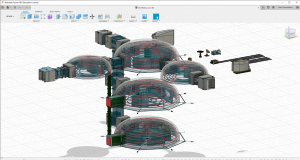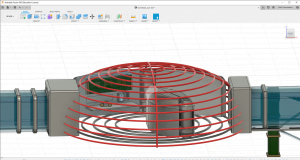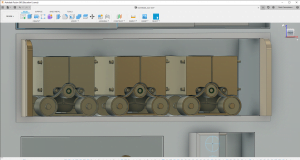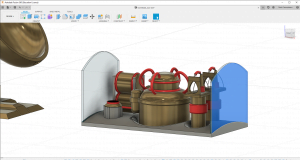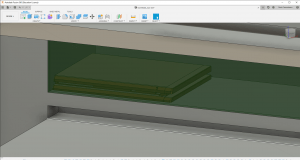|
Describe your Moon Camp project.
The base we have designed, is a three-level structure, with an independent inflatable module on each level. All modules are connected to an elevator/stairs shaft. The radius of the modules should be adapted to the local topography, probably around 5-6 meters with 3.5-3.7 meters maximum high. All three modules will be separately pressurized.
On the vertical axis, should measure 8 to 10 meters underground. The surface dome structure (not the inflatable module) will have the shape of a hemisphere. The actual size should be decided after the original scanning of the site, probably no more than 7 meters diameter, not counting the semicylindrical extensions to cover the airlocks.
The whole idea to use lava tubes is based is the possibility to extend the structure inside the underground potential tunnel network. In time a continuous chain of inflatable modules could radiate from these entry points.
Where do you want to build your Moon Camp?
We consider that the best location for a permanent Lunar Base is Philolaus crater, positioned at 72.1 N; 32.4 W. PC dates of Copernican age, and the impact melt deposits on its central-eastern part are among the youngest lava flows discovered on the Moon, this means that the access shaft to the lava tubes could be stable enough. The observations revealed the existence of relatively circular shafts, interpreted as lava tubes skylights or post-flow features. We were not able to find any closer shafts to the Pole. This can be the access to subsurface voids and potentially vast networks of larger subsurface cavities isolated from lunar surface environmental conditions. A number of relatively horizontal and smooth areas, suitable as landing sites were identified on the floor of Philolaus Crater near the lava tube shafts sites. Earth communication is possible because it is directly visible from most locations of Philolaus Crater.
How do you plan to build your Moon Camp? Describe the techniques and materials you would use.
We are going to use a two stage mission.
First stage will be robotic, containing a number of autonomous units able to link together reinforce the shaft and build the outer dome. The material used will be lunar regolith sintered by heat using microwaves or lasers. The printing techniques should be the same used in old pottery, an ascending spiral, with the upper layer build over the lower one. Inside the shaft will be a three-level structure For the floors, we have decided the best solution is a partially elastic cable system anchored on the shaft wall, like a spider web.The crew will have to inflate the main modules and to ensemble the connexion systems.
Inflatable modules lacks rigidity. To solve this, we have suggested an integrated design inspired by insect wings. There will be an additional layer of microtubes filed with synthetic resin, able to rigid the whole structure
|
|
Since Luna 24, a multitude of extraction systems were developed, but all have the same basic principle, heat the material to release water as gas and capture it.
We intend to use something based on the recent ESA’s new Advanced Closed Loop System, designed by Airbus. Similar systems were developed by NASA. The CO2 produced by metabolic processes will be removed from the modules atmosphere, reacted with H2 in a Sabatier methanation reactor, to generate methane and water. A highly efficient closed-loop will result in a near-complete closure of O2, which would significantly reduce the required amount of water resupply.
|
Space allocated for the aquaponic system module is 6 meters radius. In the center should be the fish and shrimps tank and the resistance structure for the growth trays, on 8-10 levels. The trays should be able to revolve independently around the center.
Around the aquaponics, will grow brown algae and yeast. Algae/yeast tanks will revolve on a circular rail. We intend to use alginate extract as bio-ink base to print food.
Our design offers 500m² growth area, theoretically sufficient to produce enough for four members. We have taken in consideration some animal protein from the fish/shrimps tank.
|
Kilopower are fission reactors using uranium 235 to power Stirling motors to generate electricity. Each unit, should generate 1 to 10 KWe. Life expectancy is 12 to 15 years.
First test was conducted in 2017 (KRUSTY), which measured less than 2 meters high. The test was successful.
Thermoelectric generators, (Seebeck generators), are designed for the outer dome. On Earth, were the temperature variations are small, the efficiency is reduced, but on the lunar surface should work.Solar power will be used on the second stage, by power cells printed on the ground by a rover similar to Lunar Vacuum Deposition Paver.
|
To transform carbon dioxide/water, into oxygen and glucose, we have decided to use a Chlorella-based generator. The idea was to design a compact unit able to sustain one person in a sealed environment. There is no preset number of replication in the genome of microorganisms, so a fair reproduction rate could be maintained. The life span should be limited by technological components only.
Our design is based on the results published in the Journal of Siberian Federal University. Biology 1 (2008) 19-39, it states that a volume of 17 liters of Chlorella culture, on 8m² is enough for 70kg bodymass.
|
|
The environment on the Moon is very dangerous for the astronauts. Explain how your Moon Camp will protect them.
The protection has three components, thermic, radiation, and meteorites shielding.
Considering the predicted temperatures (day/night; sunny/shadow; interior/exterior) and a number of exothermic ongoing processes inside the base, there should be a flexible heat exchange system to regulate the temperature.
The first layer of protection against radiation will be the lunar surface itself because most of the base is going to be underground.
The exterior dome should have an extra layer of protection, probably based on some material rich in hydrogen. We think polyethylene is the best option.
For a long ter missions, there should be an active protection system. The best solution available is a double layer shield, an electrostatic positive field on the outside, to repel positive particle and a negative magnetic field inside.
There is no perfect solution for protection against meteorites.but the base is mainly underground, the outer dome could be covered with regolith,.
|
|
Describe a day on the Moon for your Moon Camp astronaut crew.
Our crew is formed by a physician/psychologist, a geologist, a structural/mining engineer, a biologist/ agronomy specialist, an informatician, an astrophysicist.
The crew’s medical condition is good, it hasn’t been reported any problem. After , breakfast taken in the middle module, the scientific data collected is transmitted to earth. The crew is receiving some personal messages.
The biologist is leaving the central module to descend in his laboratory closed to the greenhouse. His study on plant germination on lunar conditions is vital for the base population expansion.
The lava tubes represent a perfect space to build a real colony on the Moon, but the food and energy autonomy is the key factor.
The astrophysicist is not so happy, his gigantic radio telescope placed inside the crater is still not performing well, so he has to spend the day reviewing old data, to find and fix the problems. There is a lot of work to do inside the lower module, on the aquaponic system. 20 trays were isolated yesterday and now their inner surfaces must be cleaned and disinfected, to be inserted again in the food growing cycle.The informatician was still eating when an alert started to glow on his console, another mining unit stopped working. These autonomous units were those old machines used to print the inner coating of the shaft, and the outer dome it is a miracle that are still functioning. The multifunctional robot must be brought back for repairs, and that means a walk outside. Usually, the geologist is the one sent on the surface, but this time, the crew’s physician/psychologist is suggesting to let the informatician do the walk. He is doing his job, overviewing the physical comfort of the crew. The geologist has enough data from analyzing the regolith. This data is sent to earth labs to analyze the past solar activity and maybe link it to historical climate change. His dream to solve the energy crisis on the earth, mining Helium 3 on the lunar surface, as the “Artemis Project” estimated, is still not viable. The helium is there, in the predicted quantities but in the absence of a Lunar-Space elevator, the transport to earth will be prohibitive.The mining engineer is preparing himself for another prospection in the lava tubes, he found a large deposit of ice, inside a natural dome, under the surface, he is now doing integrity simulations
|


